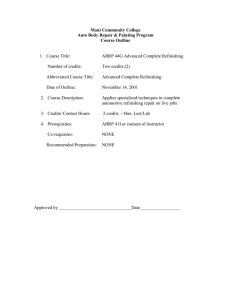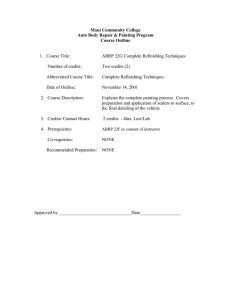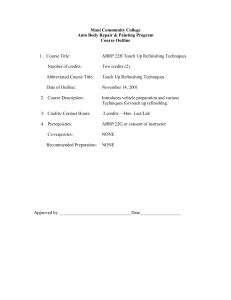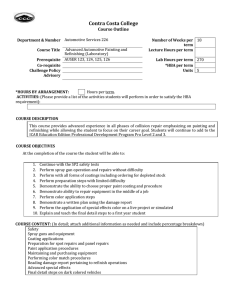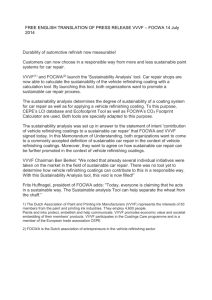QTB12A Bumper Handling and Refinishing
advertisement
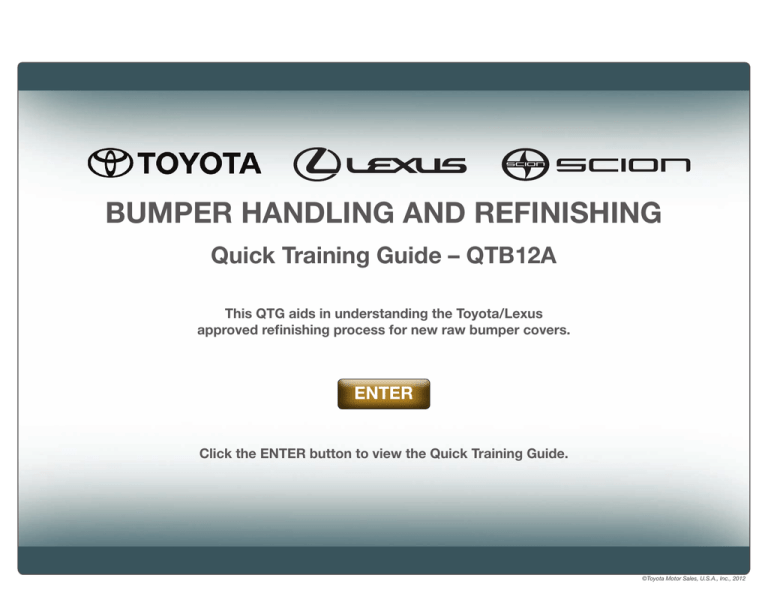
Bumper Handling and Refinishing Quick Training Guide – QTB12A This QTG aids in understanding the Toyota/Lexus approved refinishing process for new raw bumper covers. ENTER Click the ENTER button to view the Quick Training Guide. ©Toyota Motor Sales, U.S.A., Inc., 2012 Bumper Handling and Refinishing Quick Training Guide – QTB12A INTRODUCTION STANDARDS DAMAGE IDENTIFICATION 10 Step Refinishing Method Introduction • New bumpers are manufactured from TSOP, Toyota Super Olefin Plastic and are engineered to be durable yet flexible. • Refinishing replacement bumper covers requires attention to detail during each step to ensure a durable long lasting finish that resists peeling and abrasion over the vehicle’s lifetime. Click the tabs at the top to view each section ©Toyota Motor Sales, U.S.A., Inc., 2012 Bumper Handling and Refinishing Quick Training Guide – QTB12A INTRODUCTION Receiving handling 10 Step Refinishing Method DAMAGE IDENTIFICATION STANDARDS storage staging transportation Dealer Bumper Cover Quality Standards • Lexus and Toyota TSOP bumpers are packaged in protective material to prevent damage during shipping. • Following Toyota’s recommended handling procedure can reduce the occurrence of deformation and abrasion damage. ©Toyota Motor Sales, U.S.A., Inc., 2012 Bumper Handling and Refinishing Quick Training Guide – QTB12A INTRODUCTION Receiving handling 10 Step Refinishing Method DAMAGE IDENTIFICATION STANDARDS storage staging transportation Receiving • DO: Inspect bumpers at the point of receipt to identify any obvious damage. •D ON’T: Improper stacking or failure to perform visual quality verification upon receipt may result in damage being passed on to the customer. ©Toyota Motor Sales, U.S.A., Inc., 2012 Bumper Handling and Refinishing Quick Training Guide – QTB12A INTRODUCTION Receiving handling 10 Step Refinishing Method DAMAGE IDENTIFICATION STANDARDS storage staging transportation Handling • DO: Carrying in the center or using a stable cart will help protect the bumper. •D ON’T: Dragging bumpers can cause un-repairable damage. ©Toyota Motor Sales, U.S.A., Inc., 2012 Bumper Handling and Refinishing Quick Training Guide – QTB12A INTRODUCTION Receiving handling 10 Step Refinishing Method DAMAGE IDENTIFICATION STANDARDS storage staging transportation Storage • DO: Store horizontally on a flat surface (in Car Position) with enough space to easily move parts in and out of location. •D ON’T: Forcing parts into locations, and excessive stacking can cause damage and deformation. ©Toyota Motor Sales, U.S.A., Inc., 2012 Bumper Handling and Refinishing Quick Training Guide – QTB12A INTRODUCTION Receiving handling 10 Step Refinishing Method DAMAGE IDENTIFICATION STANDARDS storage staging transportation Staging • DO: Stage in an area that will not result in parts being hit, kicked or struck. •D ON’T: High traffic areas increase potential for damage. ©Toyota Motor Sales, U.S.A., Inc., 2012 Bumper Handling and Refinishing Quick Training Guide – QTB12A INTRODUCTION Receiving handling 10 Step Refinishing Method DAMAGE IDENTIFICATION STANDARDS storage staging transportation Transportation • DO: Transport in horizontal position (Car Position) and avoid stacking and/or contact with other objects. •D ON’T: Contact with sharp edges can cause scratches, gouges or dents. ©Toyota Motor Sales, U.S.A., Inc., 2012 Bumper Handling and Refinishing Quick Training Guide – QTB12A INTRODUCTION Scuffs & Scratches DAMAGE IDENTIFICATION STANDARDS ScraTCHES & Gouges ScrATCHES on Textured Surfaces 10 Step Refinishing Method Deformation or Broken Tabs Repair V.S. Replace Damage Identification • Scuffing or other minor scratch marks caused during the handling process are normal, and will be corrected during the approved paint preparation process. • Use the following guide to determine the extent of the damage. Minor Surface Scuffs and Scratches Excessive Deformation or Broken Tabs 28 09Pag Deep Scratches and Gouges Scratches on Textured Surfaces e1 of 2 Repair vs. Replace d on age dam a claim r htly u 0% slig filing y o ing y for entiall ceed 5 n r retu s polic . Ess ot ex n re with ry cy ted cedu delive sts do r Poli o ocia pro ass repair dling o pair c es r ts u s n r re p rs ced e co ce ou ring ha if the e o sho iz r g r P im t ody ana 009 info e du par min pair eb 1, 2 nd nd re amag able ts M t Re utsid y1 ea a d ir Par Ma Par rvic duce imal repa or o e r d s er intro d min e any eale age e tom ed re c : Dam cus ke to r incur repla y th TO d b ses ely e li T: lete n hav than t tim uld mp expe JEC por S wo t may ather o B p c u g s be agin SU , TM tha air r t to can ck and ffor nt parts n parts to rep pair repa PDC arts ne IV-4 s re and rn to tion of p In a ceme collisioealers t. -3, g ea la r rity tu c e: e es IV teg rep irable for d he pa lac cle tim andlin for re redu eplac g p a in e a t R rm cy ery, h part me rsus r n, p d fi s ti rep uest is e of o e ir n u ti g a d d o s v e a p c of orta ver age h lea air v deli r re req he valu dam days and nsp pair tome curring ss dam throug gh rep tly age Tra of t e c uen ess f Re cus am 0 nd rou tion roc s o uces of reo e3 ic a freq usin ny d to p tisfac ent th efit d raff n hav for (3) b te a T e u ta g o Ben • Re ductio s need er sa ironm e IV o a hre y to am t to n tion Re inate ustom n env hen d D ithin ged : eipt ers Sec -12 o y, t nt c a le s • m l c r t it e a li s a e u c r w r d e e m E u c nu 1, V pon usto C pa mo eme enco rov • ced Ma 1 Con PD u Imp uces im com burs ongly Pro Parts ges V- ment party c “R9” acing d d r d • e r tr im n ta , pa a ag ir re are s Re s fo ship third age o our f s cy oyo am a ure • Poli nce T rogram n parts arts to r Dam tact y imate ent d r rep t, you ced r e im o n u t o pro Cla Refer port P heck iting p Carrie en co air es n-freq laim f the pa im air. la ir c a p t c p f rep o ed th y: gc ge Rep Polic n V Su quality exp Freigh low), g a re for n mage alue o win ma if r to tio 3” follo da it v be m uin age ( r da the Sec Perfor nt prio e is “R chart purs Dam file a the un w . t fo eceipt e n s e lo e d e g f u d vice m a o le n ar ee be e • ry r sem Ser ship rt dam ies (s you oncea ate a 50% ribed leas bur elive ery e d c a le, p eliv reim e d If p modit advis “R9” C ir estim excee s des irab ng y of th dD a a t ti m a • e o is p t o s it o d p t c ers ue cop age a re tten es n lace ut re eip tom req a db rec rt dam rsue ate do n rep Una cus are ill and age a u a op ime ou . If p s to p estim ther th dam y sh dures at y epair b ht-T . d ir ly th ig y • o a a e te da e rep art r r N hours er visib as b proc p dica of th d fo t is well and If th ir the C d in uire to 48 . tha a • art l, as policy y an ing PD elivery ot req in 24 rep ap n nne c h d Dail rso repair ler our fa e of age is air wit eive nt. e a c p e t e y r e p D tim m par vice via can to ge at ng da t of re you ursem ser mage b a ti s uld os laim nd 0 Sho ir reim dures age c end a s dam t nota r the c ts a MS da ()0 a s ip par T rep Proce e dam py or t notatey rece edit fo our ing of y il r r o a c F h c e wit stand 9 1. Fax a able) th f deliv claim n ) r o ( ti e o 10 2. applic Copy n issue rma und (X) 00 : info lear e this ve a c Note will th ()0 6 C a iew PD rev lved h (X) u o 3. at y s invo ()7 t th e ues ll parti ()8 ©Toyota Motor f req a ()4 g We nsure 4 ) ( to e O: N 4c ()5 Sales, U.S.A., Inc., 2012 Bumper Handling and Refinishing Quick Training Guide – QTB12A INTRODUCTION Scuffs & Scratches DAMAGE IDENTIFICATION STANDARDS ScraTCHES & Gouges ScraTCHES on Textured Surfaces Deformation or Broken Tabs 10 Step Refinishing Method Repair V.S. Replace Minor Surface Scuffs and Scratches • Packaging and occasional contact may scuff the raw bumper surface. • Fingernail will not catch in scuff. •B ecause the bumper requires washing and scuffing during the refinish process, these issues will be eliminated by the refinish technician. Acceptable scuffing due to contact with packaging ©Toyota Motor Sales, U.S.A., Inc., 2012 Bumper Handling and Refinishing Quick Training Guide – QTB12A INTRODUCTION Scuffs & Scratches DAMAGE IDENTIFICATION STANDARDS scratches & Gouges SCRATCHES on Textured Surfaces Deformation or Broken Tabs 10 Step Refinishing Method Repair V.S. Replace Deep Scratches and Gouges • Scratches and gouges that cause your fingernail to catch require additional attention during preparation. •T hese may be eligible for repair reimbursement or return.* *Per guideline outlined in the parts policy manual. ©Toyota Motor Sales, U.S.A., Inc., 2012 Bumper Handling and Refinishing Quick Training Guide – QTB12A INTRODUCTION Scuffs & Scratches DAMAGE IDENTIFICATION STANDARDS ScraTCHES & Gouges SCRATCHES on Textured Surfaces Deformation or Broken Tabs 10 Step Refinishing Method Repair V.S. Replace Scratches on Textured Surfaces • Inspect for scratches on textured surfaces. • Scratches of any type on textured surfaces may be eligible for return.* Scrape on bumper (white) Gouge on bumper *Per guideline outlined in the parts policy manual. ©Toyota Motor Sales, U.S.A., Inc., 2012 Bumper Handling and Refinishing Quick Training Guide – QTB12A INTRODUCTION Scuffs & Scratches DAMAGE IDENTIFICATION STANDARDS ScraTCHES & Gouges SCRATCHES on Textured Surfaces 10 Step Refinishing Method Deformation or Broken Tabs Repair V.S. Replace Excessive Deformation or Broken Tabs • Inspect for excessive damage. Deformation • These examples may be eligible for return.* Broken tabs *Per guideline outlined in the parts policy manual. ©Toyota Motor Sales, U.S.A., Inc., 2012 Bumper Handling and Refinishing Quick Training Guide – QTB12A INTRODUCTION Scuffs & Scratches DAMAGE IDENTIFICATION STANDARDS ScraTCHES & Gouges SCRATCHES on Textured Surfaces 10 Step Refinishing Method Deformation or Broken Tabs Repair V.S. Replace Repair vs. Replace • TMS Damaged Part Policy provides reimbursement for repairs up to 50% of the value of the part. 09- 28 May 11, 2009 • Return policy details are contained in PANT Bulletin 09-28. Page 1 of 2 TO: Parts Managers SUBJECT: Damaged Part Repair Procedures Policy In an effort to support timely customer service and minimize costs associated with returning slightly damaged replacement parts, TMS would like to reintroduce and reinforce our repair procedures policy for filing a claim on repairable collision parts that may have incurred minimal damage during handling or delivery. Essentially our request is for dealers to repair rather than replace any repairable part if the repair costs do not exceed 50% of the value of the part. Benefits of Repair versus Replace: • Reduces customer repair cycle time as repair can be completed by the dealer or outside body shop • Reduction of reoccurring delivery, handling and repackaging expenses • Eliminates need to process damaged part for return to PDC • Improves customer satisfaction through lead time reduction • Reduces impact on environment through repair versus replace Repair Claim Policy and Procedures: Policy: Reference Toyota Parts Manual Section IV Traffic and Transportation, pages IV-3, IV-4 and Section V Support Programs, pages V-11, V-12 • Perform quality check on parts shipment upon receipt to notate any damage and confirm integrity of parts shipment prior to expediting parts to third party customers • If part damage is “R3” Freight Carrier Damage or “R9” Concealed Damage for frequently damaged commodities (see chart below), then contact your facing PDC within three (3) business days of receipt to advise you are pursuing a repair estimate • If part damage is “R9” Concealed Damage for non-frequent damaged commodity, then you have 30 days to pursue a repair estimate and file a damage claim for repair reimbursement • If the repair estimate does not exceed 50% of the unit value of the part, you are strongly encouraged to repair the part rather than replace it as described below Should you receive a part that is visibly damaged but repairable, please use the following claim procedures for repair reimbursement. Procedures 1. File damage claim via Dealer Daily and indicate that you are requesting reimbursement for damage repair. 2. Fax a copy or send a scan to your facing PDC of the repair bill and a copy of the delivery receipt (if applicable) that notates damage at time of delivery. Note: Copy of delivery receipt notating damage is not required for Night-Time Unattended Delivery Service. 3. PDC will then issue claim credit for the cost of repair within 24 to 48 hours. We request that you review this information with your parts and service personnel, as well as body shop customers to ensure all parties involved have a clear understanding of TMS damage part repair policy and procedures. DISTRIBUTION LIST NO: (X) 1 (X) 4 ( ) 4c (X) 2 ( ) 4a ( ) 4d ()3 ( ) 4b ( ) 4e ( ) 4f ( ) 4g ()5 (X) 6 ()7 ()8 ()9 (X) 10 ( ) 000 ( ) 00 ©Toyota Motor Sales, U.S.A., Inc., 2012 Bumper Handling and Refinishing Quick Training Guide – QTB12A INTRODUCTION Washing Dry & Inspect DAMAGE IDENTIFICATION STANDARDS SCUFFING Spot Repair Anti-Static Adhesion Promoter Sealer 10 Step Refinishing Method COlor COat Clear Coat De-Nib & Polish Toyota/Lexus 10 Step Method for TSOP Bumper Cover Refinishing 1 Washing 6 Adhesion Promoter 2 Dry & Inspect 7 Sealer 3 Scuffing 8 Color Coat 4 Spot Repair 9 Clear Coat 5 Anti-Static 10 De-Nib & Polish ©Toyota Motor Sales, U.S.A., Inc., 2012 Bumper Handling and Refinishing Quick Training Guide – QTB12A INTRODUCTION Washing Dry & Inspect DAMAGE IDENTIFICATION STANDARDS SCUFFING Spot Repair Anti-Static Adhesion Promoter Sealer 10 Step Refinishing Method COlor COat Clear Coat De-Nib & Polish Washing • New bumper manufacturing uses a release agent during the molding process. • This release agent must be washed off the bumper with soap and water before the scuffing process can begin. • Failure to remove this release agent before scuffing will embed it into the plastic and prevent paint adhesion. ©Toyota Motor Sales, U.S.A., Inc., 2012 Bumper Handling and Refinishing Quick Training Guide – QTB12A INTRODUCTION Washing Dry & Inspect DAMAGE IDENTIFICATION STANDARDS SCUFFING Spot Repair Anti-Static Adhesion Promoter Sealer 10 Step Refinishing Method COlor COat Clear Coat De-Nib & Polish Dry and Inspect • After washing, dry and inspect the bumper. • Look for areas that will require attention during the scuffing step. Washing Inspect Alcohol Wax & Grease ©Toyota Motor Sales, U.S.A., Inc., 2012 Bumper Handling and Refinishing Quick Training Guide – QTB12A INTRODUCTION Washing Dry & Inspect DAMAGE IDENTIFICATION STANDARDS SCUFFING Spot Repair Anti-Static Adhesion Promoter Sealer 10 Step Refinishing Method COlor COat Clear Coat De-Nib & Polish Scuffing • Thoroughly scuff the bumper with sanding paste and a pad. • Clean, dry and inspect the paintable surface for a uniform dull appearance that will promote paint application and adhesion. Paste on Scotch Brite Rubbing Inspect ©Toyota Motor Sales, U.S.A., Inc., 2012 Bumper Handling and Refinishing Quick Training Guide – QTB12A INTRODUCTION Washing Dry & Inspect DAMAGE IDENTIFICATION STANDARDS SCUFFING Spot Repair Anti-Static Adhesion Promoter Sealer 10 Step Refinishing Method COlor COat Clear Coat De-Nib & Polish Spot Repair • If the bumper requires a minor repair perform the repair using fillers and primers formulated for flexible surfaces. Staged w/o filler bead with bead of filler ©Toyota Motor Sales, U.S.A., Inc., 2012 Bumper Handling and Refinishing Quick Training Guide – QTB12A INTRODUCTION Washing Dry & Inspect DAMAGE IDENTIFICATION STANDARDS SCUFFING Spot Repair Anti-Static Adhesion Promoter Sealer 10 Step Refinishing Method COlor COat Clear Coat De-Nib & Polish Anti-Static • Move the bumper into the booth and apply with a suitable anti-static product. ©Toyota Motor Sales, U.S.A., Inc., 2012 Bumper Handling and Refinishing Quick Training Guide – QTB12A INTRODUCTION Washing Dry & Inspect DAMAGE IDENTIFICATION STANDARDS SCUFFING Spot Repair Anti-Static Adhesion Promoter Sealer 10 Step Refinishing Method COlor COat Clear Coat De-Nib & Polish Adhesion Promoter • Apply an adhesion promoter designed for use on plastic surfaces. ©Toyota Motor Sales, U.S.A., Inc., 2012 Bumper Handling and Refinishing Quick Training Guide – QTB12A INTRODUCTION Washing Dry & Inspect DAMAGE IDENTIFICATION STANDARDS SCUFFING Spot Repair Anti-Static Adhesion Promoter Sealer 10 Step Refinishing Method COlor COat Clear Coat De-Nib & Polish Sealer • Apply a sealer per the paint manufacturer’s directions. ©Toyota Motor Sales, U.S.A., Inc., 2012 Bumper Handling and Refinishing Quick Training Guide – QTB12A INTRODUCTION Washing Dry & Inspect DAMAGE IDENTIFICATION STANDARDS SCUFFING Spot Repair Anti-Static Adhesion Promoter Sealer 10 Step Refinishing Method COlor COat Clear Coat De-Nib & Polish Color Coat • Apply the color coat to the bumper following the paint manufacturer’s mixing directions. ©Toyota Motor Sales, U.S.A., Inc., 2012 Bumper Handling and Refinishing Quick Training Guide – QTB12A INTRODUCTION Washing Dry & Inspect DAMAGE IDENTIFICATION STANDARDS SCUFFING Spot Repair Anti-Static Adhesion Promoter Sealer 10 Step Refinishing Method COlor COat Clear Coat De-Nib & Polish Clear Coat • Apply a clear coat when applicable per the paint manufacturer’s directions and bake the required time. ©Toyota Motor Sales, U.S.A., Inc., 2012 Bumper Handling and Refinishing Quick Training Guide – QTB12A INTRODUCTION Washing DAMAGE IDENTIFICATION STANDARDS Dry & Inspect SCUFFING Spot Repair Anti-Static Adhesion Promoter Sealer 10 Step Refinishing Method COlor COat Clear Coat De-Nib & Polish De-nib and Polish • If needed, perform de-nibbing to remove dust and imperfections then polish. De-Nib tool 3in buffer ©Toyota Motor Sales, U.S.A., Inc., 2012
